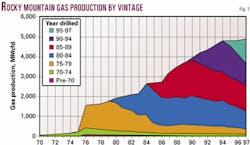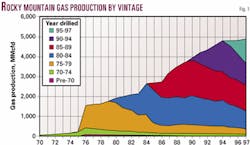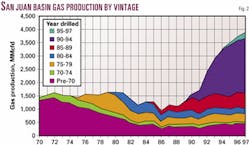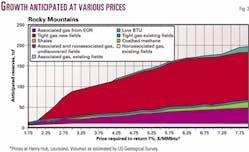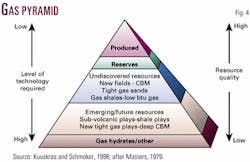As a result of new technology, the Greater Rocky Mountain Region (GRMR) has been the home to more giant fields "discovered" in the last 10 years than any other major US onshore province.
What's more, it is one of only two provinces that have been growing in production during that time. Rocky Mountain and San Juan basin gas production have grown continuously (Figs. 1, 2). Note the major anticipated growth in new tight gas fields with increasing price (Fig. 3).
Although recent advances in all technological aspects of exploration and exploitation have been important in this renaissance, equally important is the geologic setting in which abundant, extremely rich source rocks for both gas and oil are liberally distributed throughout underexplored provinces.
The first part of this two-part article deals with the new technology. The second part deals with the resulting eight probable giant fields found in the GRMR in the 1990s. These fields are in various stages of development. The article is extracted in part from Meissner and Thomasson.1
Summary
The GRMR is a large, geologically heterogeneous area that contains numerous basins and uplifts. Although it contains a wide variety of structures generated at different times, those generated in the Lower and Upper Tertiary are commercially the most significant.
Numerous oil prone and gas prone source rocks and prospective reservoirs are present, and these have contributed to the presence of a large number and variety of petroleum systems. Productive and prospective reservoirs include a spectrum of carbonates and sandstones that contain matrix porosity and permeability, as well as fracture-type and coalbed methane reservoirs.
Several investigating entities have estimated the potential for future producible hydrocarbon discoveries to be 10.4 to 15.4 billion bbl of petroleum liquids and 192 to 260 tcf of gas.
Of particular significance to further exploration and development potential are a class of unconventional accumulations associated with pervasive regional hydrocarbon saturation, a general absence of movable ground water, and the presence of either abnormally high or low fluid pressures. These accumulations may be dynamic and transient in nature and commonly occur in low-permeability or fractured reservoirs associated with mature source rocks in the deeper parts of typical Rocky Mountain basins.
Petroleum systems present in the Cretaceous and Lower Tertiary section will be major contributors to future hydrocarbon production, and gas will be of particular importance because of the large number of coal measures present. Gas generated by thermal or bacterial processes is present in coal beds and nearby sandstone reservoirs. Exploration and development opportunity is present in regions associated with confirmed high generation-capacity source rocks but with little established production.
Much of the potential hydrocarbon resource remaining to be discovered and developed is characterized as representing the largest overall volume in the "resource pyramid." The exploitation of this resource will depend heavily on the price of the product and the application of new and developing technology that will lower the cost of exploration and enable economically attractive development.
Most of the eight so-called "discoveries" of the 1990s represent hydrocarbon accumulations known through prior exploration. They had little economic significance until the development of geologic understanding, drilling, evaluation, and completion technology rendered them economically viable.
These eight giants have been developed by:
- Being "rediscovered" and exploited by new technology;
- The merger of isolated coalbed methane deposits into giant fields; and
- The development of central basin gas deposits and their eventual merging into giant fields. This is an indication of the type and magnitude of remaining resource type and potential in the Rocky Mountain province.
New technology applied
Application of new technology has been an important element in discovering and establishing new oil and gas reserves in the GRMR.
Many developments have occurred in areas where the presence of hydrocarbon saturation was known but hydrocarbons could not be economically produced with then-existing capabilities. Considerable effort is under way to develop new concepts, techniques, and abilities in almost every category that bears on exploration, development, and production.2 3 These developments have been so extensive that only a summary of those considered to be the most significant is presented here.
Basic geology
Constant advances have been made in understanding basic petroleum geology, both as a fundamental science applicable on a global scale and to specific regional cases.
As applied to the GRMR, these include such items as structure,4-8 stratigraphy,9 10 source rock presence and maturity,11 and reservoir development and behavior.9 10 12-17 The latter is directly related to the development of both Cave Gulch and Jonah gas fields, discussed in part two, where the understanding of initial drainage of thick, stacked pay intervals is important.
Seismic techniques
The use of modern seismic acquisition and processing techniques has had a profound influence on exploration and development in recent years.
Because most Rocky Mountain reservoirs have low porosity, "bright spot" phenomena have not been notably successful in directly identifying hydrocarbon accumulations. However, high frequency 2D, 2D swath, and 3D methods, coupled with an enhanced understanding of how reflection amplitude, frequency, anisotropy, interval velocity, and other attributes represent geologic conditions of structure and stratigraphy, have resulted in numerous successful discoveries.
Unusual or complex structures such as overthrust areas, shear zones, and meteor impact features have been interpreted through the use of analog geologic models. Similarly, reefs, mounds, channels, and other stratigraphic features have been identified. The advances in seismic technique and interpretation will have a great impact on future exploration and development.
Using some old (interval velocity studies) and new (fracture identification using anisotropy) techniques has allowed exploration for sweet spots within the basin centered gas settings. These techniques are being exploited in several Rocky Mountain basins.
Data management
The thousands of wells drilled in the GRMR have generated an extremely large amount of basic geologic and engineering data.
Modern computer techniques have been and are still being developed to sort, analyze, and plot this large volume of information. This continuing development will undoubtedly aid in identifying exploration prospects and development projects.
Drilling through completion
Advances in well drilling, evaluation, and completion technology have had a significant impact in exploration and development.
Horizontal wells offer great promise for exploiting reservoirs that are thin, have low permeability, are compartmentalized or fractured, or contain viscous oil. Although the chief application of horizontal drilling in the Rocky Mountain region has been in developing fractured reservoirs, opportunity exists in many other reservoir types and conditions.
The largest oil field found in the last 10 years is Cedar Hills in North Dakota and its companion, East Lookout Butte in Montana. This field has been developed with horizontal drilling of an extremely thin (less than 10 ft) reservoir.
Many Rocky Mountain reservoirs are substantially underpressured and have been penetrated with wells utilizing standard but overbalanced mud systems. Many of these reservoirs have undergone extensive reservoir damage that can be minimized by drilling with recently developed underbalanced mud and flow control drilling systems. Utilization of downhole motors and slim hole drilling has lowered drilling expenses and increased profits in the Denver basin and made some uneconomic reservoirs viable development targets.
The development and use of formation imaging logs has aided the identification of depositional and structural features. These logs have proven especially useful in the evaluation of fractured reservoirs. Better understanding of log behavior in low resistivity, low contrast formations has led to better evaluation of potentially productive intervals in new or existing wells.
Hydraulic fracturing of low permeability reservoirs in the Rocky Mountain area has produced economic production rates. Considerable progress has been made in designing less expensive and more efficient techniques, and improvements continue. Hydraulic fracture stimulation has proven successful in coalbed methane development.18 Cavity enlargement ("cavitation") has also proven to be a viable technique for enhancing coalbed methane production.19
The resource pyramid
Masters20 first proposed the concept of a resource triangle applied to an assessment of the economic viability of existing petroleum deposits in 1979. Thomasson21 subsequently adapted the concept, and Kuuskraa and Schmoker22 modified it into a resource pyramid (Fig. 4).
The pyramid's apex represents a relatively small amount of oil or gas in very rich, easily found and exploited fields that have highly favorable economics.
Most of the total available resource lies in the lower portion of the pyramid in leaner and less easily found and exploitable accumulations associated with poor or unprofitable economics. At any given time the ability to move downward from the apex of the pyramid depends on the price of the product and the finding and producing costs. Increasing technical capability gives the explorationist and the exploitationist the ability to discover commercial oil and gas from leaner accumulations.
In the case of oil, several recent plays demonstrate the trend toward exploiting resources in the lower portion of the pyramid. Examples of this are production established from fractured reservoirs in:
- Limestones in the Niobrara formation at Silo oil and gas field in the southeast Wyoming part of the Denver basin;
- Shales and siltstones of the Bakken formation "Fairway Trend" in the North Dakota part of the Williston basin;
- Shale in the Cane Creek member of the Paradox formation in the Paradox basin of eastern Utah; and
- Siltstones, sandstones and limestones of the Turner, Muddy, and Niobrara formations of the Powder River basin. All of these examples represent basin centered type accumulations developed in mature source rocks. Fractured reservoirs in the Bakken and Cane Creek are substantially overpressured; those in the Niobrara at Silo field are slightly underpressured.
We see very significant additional opportunities for these play types in the San Juan, Uinta, Powder River, Denver, Paradox, and Williston basins and many basins of the Basin and Range Province.
Part of the reason major oil companies failed in their most recent (mid-1980s) attempt to explore and exploit the Rocky Mountain region is that most of the reserves remaining to be discovered are in unconventional settings and the technology to take advantage of them had not yet been developed. For example, horizontal drilling technology has only recently been sufficiently developed to allow the extraction of hydrocarbon accumulations in fractured, thin, or compartmentalized reservoirs to be exploited commercially.
With further technological advances of all kinds, an increasing volume of rock will become attractive for effective exploration and economic exploitation.
The shape of the resource pyramid that depicts a large resource province (Fig. 5a) clearly describes a much larger potential resource base than that shown in Fig. 5b, which depicts a limited resource province. The volume to height ratio is greater in 5a and increases exponentially downward from the apex.
The extremely large coalbed gas resource and the variety of basin centered or continuous type oil and gas accumulations generally associated with large but poor quality accumulations are abundant in the GRMR. This is best characterized by the middle portion of the much broader pyramid (Fig. 5a). A position in the middle of the broader pyramid is highly favorable for exploiting large reserves, provided the technology for doing so is available and economic considerations are favorable.
Most of the oil and gas postulated by the US Geological Survey to be technically available for future exploration and exploitation is contained in the survey terms "unconventional" continuous type accumulations that occur in the middle part of the broader resource pyramid. Generally characterizing these accumulations are "tight" matrix porosity and-or fractured reservoirs, anomalous pressures, large areas of complete hydrocarbon saturation, and coalbed methane.
Next: Examples of recent significant "discoveries:" Analogs for the future.
